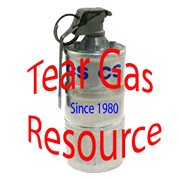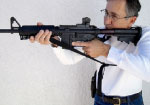Should We Use Chemical Agents When There is a Hostage Present?
The question, should we use chemical agents when there is a hostage present, was asked by a CAI. Corporal Will Bunk a San Diego Sheriff’s Department Chemical Agent Expert assigned to the Special Enforcement Detail answered that question.
“I'll try to answer your questions in regards to liability in using gas in a structure where there are hostages and or subjects unrelated to the incident but failing or refusing to leave.
Let's start with the first part reference the use of chemical agents during a hostage situation. This is a circumstantial situation. I can't give you a clear black and white answer on this due to the multitude of factors that can go into this. Ask yourself these questions before deploying chemical agents into a structure during a hostage situation:
1. Will this motivate the hostage taker into overt acts, such as killing off hostages?
If you introduce chemical agents in a hostage environment, you need to have a plan on what happens if the desired effect doesn’t happen immediately or nothing happens to the hostage taker at all? The next thing you must plan for is making a hostage rescue entry into a chemical agent environment that has low visibility. This may have to be done due to us 'forcing' an unplanned reaction on the hostage taker once we introduce chemical agents into the environment, such as them beginning to shoot hostages. Lastly, to what level of training does the team do in low visibility hostage rescue entries with a gas mask on while shooting and moving?
2: What is the purpose behind introducing chemical agents into the structure?
Although the obvious answer would be to disorient the hostage taker to gain an advantage but what you need to make absolutely sure of is he is separated from the hostages and has no means to defeat the agent. As you know the hot gas takes time to fill a room. If you are not in the "cloud" of CS, you are unaffected or minimally affected. Also, if you introduce chemical agents where the hostages are, they will be adversely affected as well.
Subjects who have not been exposed to chemical agents can become overwhelmed with added fear due to the effect on their eyes (involuntary closure/burning sensation), some will freeze and be unable to move and will drop to the ground because of the feeling they cannot breathe along with the sensation of your exposed skin being irritated.
Based on the above, this will take serious manpower to physically move these hostages out of harm's way to safety which is time that the hostage taker can continue to act. Remember, all the hostage taker has to do is blindly fire and hit someone and they accomplish their mission.
If you can answer those two questions and have plans put in place and still feel confident with the plan to use chemical agents, then you can argue the exigency of the situation for the use of chemical agents. That in turn is where liability will become an issue or non-issue. And of course, it will ultimately lie on your department, the department P&P, the unit P&P, your SOPs, and the amount of training you document to operate in those types of environments.
Now for the second part of your question, subjects unrelated to the incident but failing to leave the structure.
I think this is easier as we deal with this all the time with unrelated neighbors and such. If you do your due diligence to give a feasible warning to the unrelated subjects and give them the opportunity to leave, if possible, and they continue to refuse to leave, well it's on them at that point. If it is a critical situation, I would try a reverse 911 call to have dispatchers notify residence of chemical agent use and possible effects so subjects can close their windows or do whatever they can to prevent chemical agents from entering their area. Just make sure there is written documentation of it. If you have tactical dispatchers that transcribe all your tactical radio traffic, include it in your after-action report.” As we all know, if it is not written down and documented in some form, 'it did not happen.'"
When Russia used a calmative agent in 2002 it didn’t work very well for them. Only 130 hostages were killed and they were severely criticized by the media. How many hostages their actions saved (680) was not the slant that the media took. (Read about this incident)
The FBI used chemical agents to end the siege at Waco Texas. The children in the compound were determined by the FBI to be hostages and not free to leave. The fire that burnt down the complex killed 76 people. There is much controversy about what caused the fire and whether the assault was even necessary. The FBI received terrible bashing from the media. (Read about this incident)
In 1983 a religious group of 7 people after killing an officer held another police officer hostage for 30 hours. After an all-night barricade situation, the Memphis PD decided to try and rescue officer Hester. Unbeknown to them, Officer Hester died several hours before the rescue attempt. Their plan was to assault from two sides simultaneously upon the insertion of tear gas grenades and “concussion” grenades in every window and door in the structure. As the assault teams entered they were met by fire and could not see across the rooms. They could see muzzle flashes and returned fire. After the assault ended all the suspects were dead. Memphis PD received a lot bad media. The suspects were black and the NAACP shouted racism. The suspects had only 3 guns between the seven people. Again, the decision to assault was questioned by the media. (Read about the incident)
 If you use this tactic be ready to change the narrative for the media from negative to positive by defending your actions. Some agencies have used the tactic successfully. In the cases I know about, the hostages were not really hostages but people that wanted to stay or a situation where the hostage taker was not threatening to the hostage (father and infant son).
If you use this tactic be ready to change the narrative for the media from negative to positive by defending your actions. Some agencies have used the tactic successfully. In the cases I know about, the hostages were not really hostages but people that wanted to stay or a situation where the hostage taker was not threatening to the hostage (father and infant son).
If you want to affect a suspect immediately with chemical agent you should use a blast dispersion method of delivery. It is the only way to immediately disperse chemical agent in a room. It will deliver your agent at the speed of the explosion that you used to disperse it. The draw back to this method of delivery is it will not stay as persistent as a burning method delivery. (Read about methods of delivery)
What chemical should you use in your blast dispersion method of delivery? This is up to your agency and availability of blast devices. CS or OC are what most agencies use today. Is one better than the other? CS is a finer particulate and will travel faster through the air. However, the difference in speed between CS and OC is indiscernible. (See article on types of agents)
How often have you trained in these conditions? Every court case I am familiar with has a component that deals with training and training records. Live-fire CQB exercises in respirators are essential in building your skills for this type of hostage rescue. Do your respirators work? Are they Powered Air Respirators? If you haven’t trained for this tactic be wary about using it. You should always be aware that you are being held to a higher standard.
In Bordanaro v. McLeod, for example, a federal appeals court found that a Massachusetts city could be held liable where departmental training "failed to address contemporary law enforcement issues, specifically ….the use of deadly force." The point is you must train in the conditions you will operate to avoid liability if something goes wrong.
If you are not trained up to the task, ask for help.




